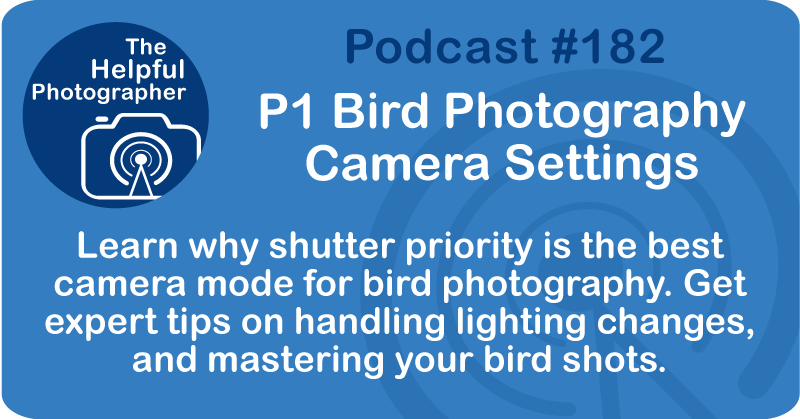P1 Bird Photography Camera Settings #182

Over the next six episodes, I'm going to talk about photographing birds because I just got home from Central and South America photographing birds with an amazing group of photographers. And wow, what a trip. The landscapes, the colors, the sheer number of birds. It was amazing. One of the highlights for us was photographing the resplendent Quetzal in Costa Rica. If you don't know what I'm talking about, Google it. They're gorgeous. And when they spread their wings, it's magic. The red, the green, the white, and those long trailing tail feathers. It's just incredible. But here's the problem. They'd sit quietly deep in the shade, almost invisible. Then, without warning, they'd shoot out into the open light. If your camera wasn't already set up to freeze that motion, you missed it. And that's exactly what I want to talk about today. What camera mode should you be using when photographing birds? Now, conventional wisdom goes like this. If stopping action matters, use shutter priority. If depth of field matters, use aperture priority. And then there's the manual mode or nothing crowd. And if this is the conventional wisdom, I want to know why do so many blogs recommend aperture priority for bird photography? Honestly, that one baffles me. Birds are fast, erratic, and constantly moving. When you shoot aperture priority, the camera is adjusting shutter speed to balance your chosen f-stop. Sounds fine, right? Except your camera assumes your subject isn't moving much, if at all.
So it's going to default to shutter speeds based on the old one over focal length rule. That might be fine for a portrait, but for a hummingbird in flight, probably not. What ends up happening is you'll get motion blur. So what the bloggers are advising is that you up your ISO to force the camera into a faster shutter speed. But the problem is you're going to miss your shot as you fiddle with the ISO to force a faster shutter speed. At that point, why not just set the shutter speed yourself? Why do this weird hybrid manual mode thing? Let me give you an example. Imagine you're shooting in bright sunlight, shooting at ISO 100, f8. Great conditions, right? With that, you're probably getting a shutter speed around 1 2,000th of a second. Perfect for freezing most action. But then the birds dart into the shade. Suddenly, your camera slows down to maybe 1 over 500th of a second, or even slower because it's dark there in the shade and because you have a low ISO of 800 and you missed a shot because the shutter speed is just too slow. Let's flip the scenario. The bird is under the canopy and you're at ISO 3200, aperture still at f8 and the bird bursts into the sunlight. Your shutter speed rockets to one over 8,000 let's say. Fundamentally, that's fine your camera can handle that and you stop the action. But you're still stuck at 3200 ISO, which means unnecessary noise when you could have been down around ISO 800. This is exactly why I recommend shutter priority with an auto ISO. You pick the shutter speed, say 1,000th or even 1 4,000th of a second, and the camera adjusts your ISO and the aperture to keep up. That way you're always fast enough to freeze motion. And yes, sometimes it means shooting wide open, but that's the trade-off. There's always a trade-off. It's rare that you'll ever get everything you want. Sorry, deal with it. That's life. And here's the thing. With modern cameras and today's noise reduction tools, a sharp image at ISO 6400 or even 20,000 looks a whole lot better than a blurry shot at ISO 800. Sharp and noisy beats blurry and noiseless every single time. Because now we have denoise programs that will help take away that noise. But the blur, for now, that's going to be a real tough one. Now, let's talk about manual mode for a second. Here's my main gripe. A lot of people think shooting in manual mode magically fixes lighting problems. Spoiler alert, it doesn't.
The M doesn't stand for magic. All right? Got it? Get over it. Your light is your light. Whether it's dawn, dusk, or the depths of a jungle, you still have to work with whatever lighting is available. The problem with shooting in manual mode, especially when you're shooting birds, is that they tend to go from light to dark to light to dark back and forth. So you're constantly having to adjust your shutter speed, your aperture, or your ISO to compensate for that light change. Most likely in a situation where you're shooting birds, you're going to be moving your ISO. But here's the thing, why not just shoot in an auto ISO and let the camera do it? One of the things I like to say is if your camera is happy to do it, why would you do it on your own? In this situation, that leaves you to only moving your shutter speed to either adjust for the fact that the bird is on a perch or if it's flying. Again, why not just shoot in shutter priority?
Alright, that said, manual does have its place. Don't get me wrong. If you're trying to balance depth of field and shutter speed, say you need an f8 instead of wide open, while hitting a specific shutter speed, manual can make sense. But it is likely that you're shooting at fairly high shutter speed because you're shooting birds. And so with settings like that, you've likely cut a lot of light out, which means you're going to have to compensate with ISO, which is what I just said. This is why I would strongly recommend using auto ISO in these situations. Otherwise, you will likely be grossly underexposed. And these days, I'm finding that if you're underexposed by more than one stop or so, you are really going to have some noise issues when you try to bring that image back up in post.
I'm aware that a lot of people out there like to set their ISO limit really low for fear of noise. Someone even told me that they don't like shooting higher than 800 ISO. While I was in Colombia, I was having to shoot at 20,000 and even 51,000 ISO very often. Doing a noise reduction on 20,000 ISO images was actually fine. I will admit that 51,000 ISO images were bad. But this is a far, far cry from ISO 800. I also found that images that were 2.5 stops overexposed at 32,000 ISO was sure as heck better than an underexposed image at 500 ISO. My undershot at 500 ISO was unrecoverable, while the overexposed shot was exceedingly tight when I brought it back. So setting a low ISO will not solve your noise problems if you end up with an underexposed shot. Remember, the M does not stand for magic. And if you're constantly adjusting your ISO manually while your subject moves between sun and shade, you're probably going to fall behind. And that's why auto ISO is such a key tool for bird photography. One extra tip. A lot of higher end cameras let you set a minimum aperture even when you're in shutter priority. So you can tell the camera, don't go wider than f4 or f8 or whatever. And it'll still work to keep your shutter speed and exposure where you want them. That can really help if for whatever reason you care about maintaining some depth of field. So let me sum it up. Shoot birds in shutter priority with auto ISO. Don't be afraid of high ISO. It's better than motion blur.
Manual mode is fine, but don't fool yourself into thinking that it solves lighting problems. If your camera supports it, set a minimum aperture while shooting shutter priority to give yourself a little more control, but be careful you're not reducing the available light too much. Bottom line, speed is king when it comes to birds in motion. Get the shot sharp first and worry about the noise later. But know that there are limits. If you're shooting that tiny little Kingfisher, 100 feet out, nothing's gonna help you, okay? You still gotta get closer. All right, that's it for today. In the next episode, I'll walk you through my shutter speed strategy, how I use custom settings to switch instantly between perched birds and birds in flight, and why that approach keeps my ISO in check while making sure I'm always ready for action. Thanks for tuning in, and if you're curious about joining me on an international photo safari, check out boundlessphotosafari.com.











